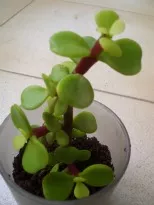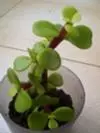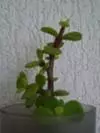by Pat
(Lanzarote, Spain)





This cutting was taken from a coastal path in Charco del Palo, in Mala, on Lanzarote, Las Palmas (Canary Islands) (17 Jul 11).
It has heart-shaped leaves and the largest leaf width is 10mm. It looks similar to a Crassula argentea that I have in London, but I have searched and searched online to no avail for this particular plant.
I hope someone will be able to help me identify this! Thanks in advance!
Drought Smart Plants reply:
I didn’t recognize this plant at first, because mostly what you see in flower shops and other places that sell plants is the variegated form; this is Portulacaria afra, the Elephants Food.
It’s native to South Africa, so it’s a bit out of it’s natural habitat, I’m imagining someone had one and it reseeded itself.
As far as I know, it’s not an invasive species, although it does seem to be very adaptable in any frost free areas.
Jacki
Comments for Cordate/Reniform leaf succulent
Jan 27, 2012
Elephants Food?
by: Jacki
Now that I revisit this, it really looks like Portulacaria, the Elephants Food.
I’ve never grown it myself, but it makes a fabulous houseplant in a bright situation, or anywhere that the weather never gets too cold.
It will eventually get quite big, but luckily, it loves being cut back, encouraging more buds to break and making it really tight and compact.
This explains why it’s used sometimes for Bonsai.
Mar 03, 2012
RE: unknown succulent
by: John
It looks like the “jade plant” my wife had…
Jade Plant on Wikipedia .. which was previously identified as “elephant food”
I hope this helps!
Apr 08, 2012
Portulacaria afra
by: Lorraine
This is undoubtedly Spekboom or elephant’s food. It is indigenous to the area in which I live in the Eastern Cape Province of South Africa. It has become highly popular in Africa as it has enormous carbon-storing capabilities, thus a huge capacity to offset harmful carbon emissions.
The leaves are edible with a pleasant, acidy taste, but are sweeter if picked in the morning. They can be used in salads.
Apr 08, 2012
¡Muchas gracias!
by: Pat
Thank you Jacki, John and Lorraine! Especially for sharing your knowledge with me- now I know the Latin name so can look up info on it online…I’m sure it has grown a bit since- I unfortunately had to leave it in the care of a friend whilst travelling. The shape of the leaf is so cute! Thanks again, Kind regards, Patricia.
Sep 14, 2012
Same conundrum
by: Simone
I too collected a sample of this crassula from Lanzarote, some years ago. The plant has grown to around 40cm tall so far, retaining the heart shaped leaves. It’s clearly not a jade plant but maybe closely related. However, I’m as mystified as anyone as to its proper taxonomy and I too would dearly love to know!


